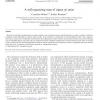Free Online Productivity Tools
i2Speak
i2Symbol
i2OCR
iTex2Img
iWeb2Print
iWeb2Shot
i2Type
iPdf2Split
iPdf2Merge
i2Bopomofo
i2Arabic
i2Style
i2Image
i2PDF
iLatex2Rtf
Sci2ools
IJON
2007
2007
A self-organizing map of sigma-pi units
By frame of reference transformations, an input variable in one coordinate system is transformed into an output variable in a different coordinate system depending on another input variable. If the variables are represented as neural population codes, then a sigma–pi network is a natural way of coding this transformation. By multiplying two inputs it detects coactivations of input units, and by summing over the multiplied inputs, one output unit can respond invariantly to different combinations of coactivated input units. Here, we present a sigma–pi network and a learning algorithm by which the output representation self-organizes to form a topographic map. This network solves the frame of reference transformation problem by unsupervised learning. r 2006 Elsevier B.V. All rights reserved.
| Added | 15 Dec 2010 |
| Updated | 15 Dec 2010 |
| Type | Journal |
| Year | 2007 |
| Where | IJON |
| Authors | Cornelius Weber, Stefan Wermter |
Comments (0)

